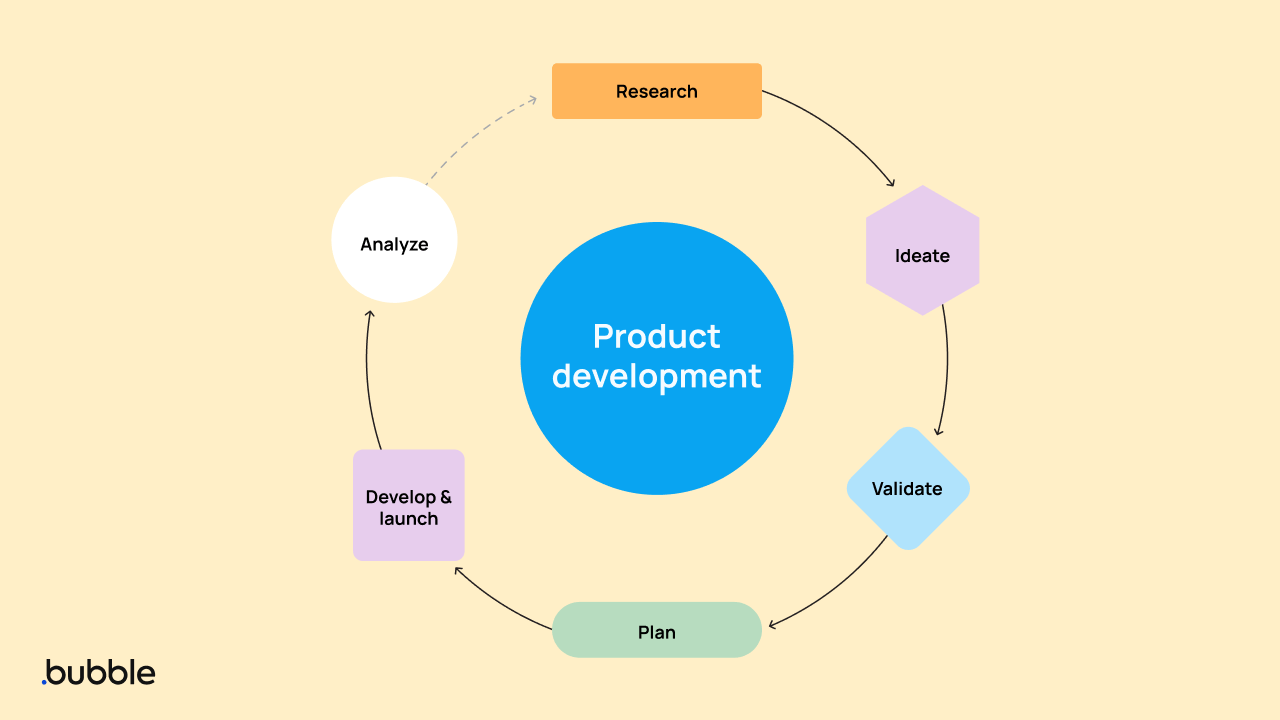When it comes to product and software development, there are a lot of competing priorities to juggle:
- Customer needs and goals
- Your company goals and business objectives
- Your (often limited) design and development resources
- Cross-team collaboration and communication
- External stakeholders and funding
Having a solid product development process in place can make it easier to manage and effectively prioritize all of these demands.
In this article, we’ll walk you through the basics of product development, including:
- What exactly it is
- The stages of the product development process
- Who should manage it
- How to create a product development plan
- and more!
What is product development?
Product development encompasses the product’s entire journey, from ideation and strategy to planning, building, and launching. It generally focuses on developing and building the product itself, but can also include tasks needed for building, like strategy and roadmapping.
Product development is often conflated with project management, but they’re not the same.
“Product development is about building the product itself. Product management is creating the strategy and informing what product development should build.” —Becky Mak, Senior Product Marketing Manager at Bubble
Product management involves the whole timeline of a product and relates to managing all aspects, from strategy to development to roadmap creation, marketing, success metrics, and more.
Product strategy and product roadmapping focus on high-level plans for the entire lifecycle, generally answering the “why” and the “what.”
Product development is typically more granular. It focuses on what needs to be developed to accomplish the desired outcomes in the larger product strategy.
What are the stages of the product development process?
It’s easy to want to think about product development as solely the building and launching phase. After all, that’s the phase where the development work is actually happening. But there’s often a lot more to the product development process than just “development.”
When you break it down, the product development process has six main stages:
- Research
- Ideate
- Validate
- Plan
- Develop and launch
- Analyze

Let’s take a quick look at each of these.
1. Conduct market research
Market research is a must for product development more generally, but can also be used for developing specific features or elements of your product.
When it comes to product development, market analysis seeks to inform:
- What your target market needs from your product
- What gaps in features or functionality exist in current solutions
- Competitive business analysis
- Where your competitive advantage lies
The long and short of it is: Talk to your target market — and keep talking to them even after the initial market research is complete. Understanding your potential customers and their needs is the best way to guarantee product-market fit and build something truly useful.
2. Cast a vision for the solution
Your product development process naturally has to include idea generation as well. Some people may consider this part of the product strategy process more than development, but there’s some overlap between the two, so it’s worth mentioning here.
Product development can’t be successful without a great vision: What exactly do you want to create, and how?
This product vision includes high-level idea generation, such as your end goal for your product and your unique value proposition (UVP). It can also include ideas and even design wireframes and sketches for how you see your product looking and functioning.
3. Validate your ideas
Before you move forward with product development, make sure to validate your ideas. This is where design wireframes, mockups, prototypes, minimum viable products (MVPs), and other testing tools can come in handy.
Keep in mind that this process holds for later stages of product development as well. If you already have a fully-functional product, creating conceptual frameworks for future feature development and gathering customer feedback before you invest in the build is always a great idea.
Not only does it help validate the problem you’re solving, but it can also help you refine and shape your approach before the build process to save time and money in the long run.
4. Build your product development roadmap
With your ideas and concepts validated, you can start planning your development of the product itself. Notice how much effort goes into development before you start building.
The earlier and more often you can test and validate your idea, the faster and more cost-effective the building process will be. It’s the startup version of the old “measure twice, cut once” principle.
At this point, you’re ready to map out the actual development that needs to happen for the next stage in your product lifecycle and strategy. To do that, you’ll want to a product development roadmap.
Note that a product development roadmap is different from a product roadmap. A product roadmap is generally a high-level visualization of your product strategy and how that'll play out across a longer timeline. A product development roadmap is more granular, zooming in on the actual work to be done at your current stage of development.
If you’ve validated your ideas and brainstormed what needs to happen next for your product, you should be in a good place to create your development plan and align the work to be done with your vision.
5. Develop and launch your MVP
Finally: It’s time to build and launch your product.
Most startup founders have traditionally preferred to first launch a prototype or minimum viable product (MVP) for testing and validation before building their actual product.
However, in today’s world of no-code tools and technology that moves faster than ever, prototypes and MVPs are a little outdated. Why would you waste time, energy, and resources building something with just enough functionality for the prototyping phase when you could use no-code to build a V1 of your product for testing and launching quickly, easily, and cost-effectively?
Bubble is a super-efficient way to build a V1 of your product that you can launch in place of a prototype or MVP. It plays the same role in that you can use it for testing and initial feedback, while seamlessly iterating your product from there so you don’t ever have to start over from scratch. Bonus: You can start growing your actual audience and getting real results from day one.
6. Iterate and grow based on feedback and goals
Ta-da! Your product is live and out in the world!
But the development process isn’t over: Now it’s time to iterate and grow based on your customer feedback and your goals.
Ongoing user testing is crucial to iterate, grow, and scale. Building on Bubble is a key way to make user testing easier — not only can you integrate user feedback tools into your product with Bubble integrations and APIs, but you can also easily iterate directly from V1 of your product.
The moral of the story: The product development cycle doesn’t have a finish line. Once you launch, keep the process in progress. Talk to your target customer groups and continue to get user feedback. Use that feedback for further development of your product.
Who manages product development?
Remember: Product development isn't quite the same as product management.
Product management covers the whole lifecycle of your product and is generally covered by your product managers or product management team.
Product development, while narrower, involves many more teams. For example: your product development team and the wider product team, but also project managers, the design team, engineering teams, sales team, and really anyone who touches the product.
The overall process for bringing your product to market isn’t dependent on a specific team but rather on the collaboration between teams.
Building with a no-code tool like Bubble also simplifies this process. Instead of needing entire engineering and design teams, you can simply build your product — the way you envision it — on Bubble.
Of course, if you want additional support, you can always hire a Bubble-Certified Developer or agency to help build, evolve, or launch your product.
What is a product development plan?
A product development plan charts out the course for the product development process. More specifically:
“A product development plan is a comprehensive, strategic document that outlines the steps, timelines, resources, and processes involved in taking a product from concept to market launch. It serves as a roadmap guiding the product's lifecycle, ensuring that every aspect of development aligns with the overall business and product goals.” — Carly Blumenfeld, Director of Product Marketing, Content, and Education at Bubble
Carly also notes that your product development plan should include:
- Analysis of the target market and competitors
- Product ideas
- Product vision
- Feature breakdown
- Tech specifications
- Design directions and wireframes
- Product launch plan
- Budget and timelines
- Potential risks
In short: The product development plan distills your product strategy and roadmap into a detailed approach for the actual build.
How to create a product development plan in 5 easy steps
Building a product development plan gives you a chance to create a detailed roadmap of the work that needs to be done to keep your team aligned and on the right track.
For a detailed deep-dive into this process, check out our guide to creating a product development roadmap. In short: there’s five key steps to follow to create a cohesive product development plan:
1. Set your goals and strategy. Determine your goals for this phase of product development, and make sure they align with larger business objectives.
2. Choose an appropriate roadmap framework. With development roadmaps, there’s two main frameworks: waterfall roadmaps or agile roadmaps. If you’re following a more traditional development process, a waterfall roadmap will get the job done. In an agile startup environment, you’ll want to use an agile roadmap to collaborate.
3. Detail the product development process. Map out the stages discussed above, and what tasks are needed to accomplish them. Think about the work that needs to be done to build your product features as well as designing them, testing them, and so on.
4. Determine stakeholders and project owners. Of course, it’s not enough to know what needs to be done — you also need to be aligned on who’s in charge of it. Your development roadmap is the right place to align project owners to make sure pieces aren’t slipping through the cracks.
5. Monitor and adjust. Just like with your product, building in an iterative review process to evolve your roadmap as things change will help keep your roadmap useful and up-to-date as you move forward with development.
Manage your entire product development lifecycle with Bubble
Ready to get your product development plan in place and hit the ground running?
There’s no better way to develop your product quickly and cost-effectively than with Bubble’s no-code tools. Speed up your product development process with our no-code, full-stack development platform that lets you build, launch, test, and iterate from day one.
Even better: Bubble gives you the tools you need to scale, so you can go from MVP to fully-fledged product all in one place.
What are you waiting for?
Build for as long as you want on the Free plan. Only upgrade when you're ready to launch.
Join Bubble






